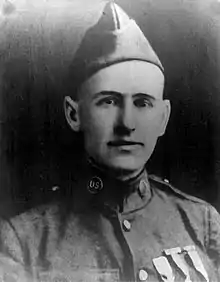Jesse N. Funk
Jesse Nathaniel Funk (August 20, 1888 – March 21, 1933) was a United States Army soldier and a recipient of the United States military's highest decoration, the Medal of Honor, for his actions in World War I. He earned the medal while serving as a stretcher bearer during the Meuse-Argonne Offensive, when he and another soldier, Charles D. Barger, entered no man's land despite heavy fire and rescued two wounded officers.
Jesse Nathaniel Funk | |
|---|---|
 Corporal Jesse N. Funk | |
| Born | August 20, 1888 New Hampton, Missouri |
| Died | March 21, 1933 (aged 44) |
| Place of burial | Calhan Cemetery, Calhan, Colorado |
| Allegiance | United States |
| Service/ | United States Army |
| Years of service | 1915 - 1920 |
| Rank | Corporal |
| Unit | 354th Infantry Regiment, 89th Division |
| Battles/wars | World War I • Battle of Saint-Mihiel • Meuse-Argonne Offensive |
| Awards | Medal of Honor |
Biography
Born in New Hampton, Missouri, Funk later moved to Calhan, Colorado, where he worked as a rancher.[1][2] He married and had one son before entering the Army in 1915.[2]
After training at Camp Funston in Kansas, Funk was sent to Europe with the 354th Infantry Regiment, 89th Division. He saw action in the Battle of Saint-Mihiel and, by October 31, 1918, was a private first class serving as a stretcher bearer in the 354th Regiment's Company L.[1][2] On that day, near Bois-de-Bantheville, France, Funk's division sent several patrols into no man's land to reconnoiter German positions in preparation for an advance as part of the Meuse-Argonne Offensive. Unusually, the patrols had been sent out during daylight, rather than waiting for the cover of darkness. Two patrols from Funk's regiment became pinned down by heavy rifle and machine gun fire. Second Lieutenant John M. Millis was seriously wounded in the legs and ordered his men to leave without him. One man managed to crawl to the safety of the Allied lines and brought news that Millis and another wounded officer were trapped in no man's land.[3]
Upon hearing this, Funk and another stretcher bearer, Private First Class Charles D. Barger, voluntarily ran 500 yards (460 m) through heavy machine gun fire with their stretcher and rescued Millis.[1][3] They then returned to no man's land and rescued the other officer, First Lieutenant Ernest G. Rowell.[3] For these actions, both Funk and Barger were awarded the Medal of Honor the next year.[1] These were the only Medals of Honor received by Army medical personnel in World War I.[4]
Funk reached the rank of corporal before leaving the Army in 1920.[5] He died at age 44 and was buried at Calhan Cemetery in Calhan, Colorado.[6]
Medal of Honor Citation

Funk's official Medal of Honor citation reads:
Learning that 2 daylight patrols had been caught out in No Man's Land and were unable to return, Pfc. Funk and another stretcher bearer, upon their own initiative, made 2 trips 500 yards beyond our lines, under constant machinegun fire, and rescued 2 wounded officers.[1]
References
 This article incorporates public domain material from websites or documents of the United States Army Center of Military History.
This article incorporates public domain material from websites or documents of the United States Army Center of Military History.
- "Medal of Honor recipients - World War I". Medal of Honor citations. United States Army Center of Military History. June 8, 2009. Retrieved 2009-07-27.
- "These Colorado Boys Get Medals". The Pueblo Chieftain. February 5, 1919. p. 2.
- English, George H. Jr. (1920). History of the 89th Division, U. S. A. The War Society of the 89th Division. p. 178.
- Greenwood, John T.; F. Clifton Berry (2005). Medics at war: military medicine from colonial times to the 21st century. Naval Institute Press. p. 79. ISBN 978-1-59114-344-4.
- Service Profile
- "Jesse N. Funk (1888 - 1933)". Find a Grave. January 26, 2003. Retrieved 2009-07-27.